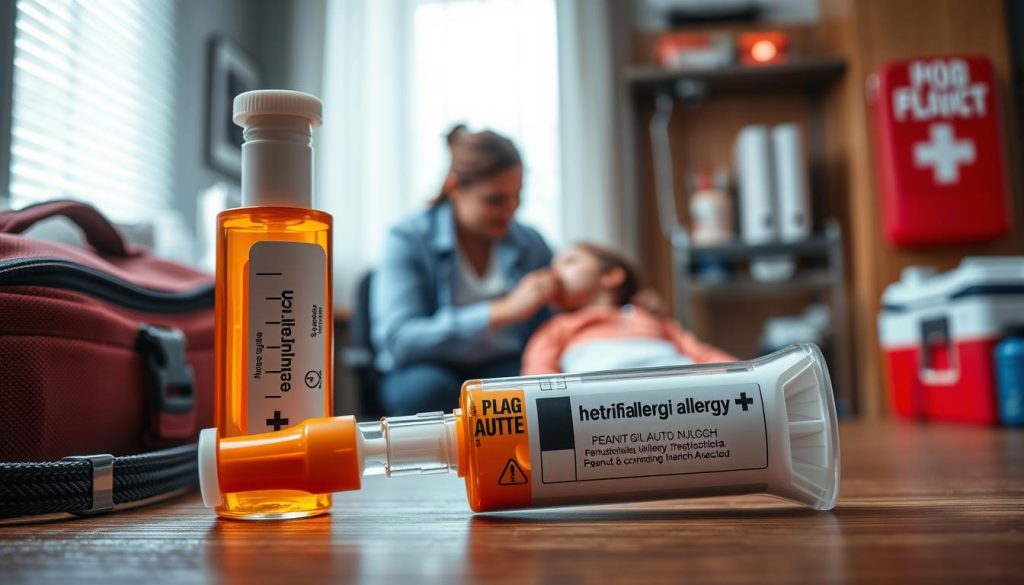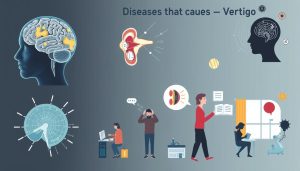Every time we eat, we trust the food we choose. This trust is especially important for those with peanut allergies. In recent years, peanut allergies, especially in children, have become more common. Knowing the signs is key to staying safe and avoiding serious reactions.
Some people might feel a little uncomfortable after eating peanuts. Others could face a life-threatening reaction called anaphylaxis. This shows how unpredictable peanut allergies can be. That’s why it’s so important to be aware.
Health-conscious adults, parents, and caregivers need to watch for these signs closely. Knowing about peanut allergy symptoms is not just helpful. It’s also a caring act that helps those affected.
Key Takeaways
- Recognizing peanut allergy symptoms is crucial for safety.
- Symptoms can vary from mild to severe, with anaphylaxis being the most dangerous.
- Spotting symptoms early is vital, especially with unpredictable allergies.
- Parents and caregivers need to be more aware of peanut allergies in kids.
- Staying informed is a key part of supporting and educating those affected.
Understanding Peanut Allergy and Its Impact
Peanut allergies are a big worry because they can be very serious. They can really affect how well someone lives. This part talks about what a peanut allergy is, how common it is, and how it changes over time.
Defining Peanut Allergy
A peanut allergy happens when the body sees peanut proteins as threats. This can cause symptoms that are mild or very serious. Knowing what causes peanut allergies is key to treating them.
The Prevalence of Peanut Allergy in Society
More people are getting peanut allergies, especially in Western countries. This has made talking about preventing and treating peanut allergies important. It’s about better food labels and getting the word out.
How Peanut Allergy Develops Over Time
Peanut allergies can start at any age and often last a long time. They are different from some other food allergies that usually get better with age. Things like family history and what you eat early on can play a role. Knowing this helps in trying to stop peanut allergies from happening.
Identifying Common Peanut Allergy Symptoms
It’s key to spot the signs of peanut allergy early. This helps in managing and treating it. We’ll look at the usual symptoms, from skin issues to breathing and stomach problems.
Skin Reactions and Peanut Allergy Rash
The peanut allergy rash is a clear sign. It shows up as red, swollen skin that might itch or hurt. It’s important to tell it apart from other skin problems like eczema or hives.
Respiratory Difficulties and Warning Signs
Problems like wheezing, coughing, and shortness of breath are serious. They happen when the body reacts to allergens. These symptoms can get worse and even lead to anaphylaxis.
Digestive Issues Related to Peanut Allergy
After eating peanuts, you might feel stomach pain, vomit, or have diarrhea. These signs show you might have a peanut allergy. They can really mess up your day and life.
| Symptom Category | Common Signs | Notes |
|---|---|---|
| Skin | Rash, Redness, Swelling | Often appears immediately after exposure. |
| Respiratory | Wheezing, Coughing | May escalate to difficulty breathing. |
| Digestive | Stomach Pain, Vomiting | Symptoms can occur within minutes. |
When Peanut Allergy Symptoms Become Serious
It’s important to know when signs of peanut allergy turn into a serious peanut allergy reaction. A severe condition linked to peanut allergies is anaphylaxis. This is a life-threatening reaction that needs quick medical help.
Here are signs that a peanut allergy reaction is getting too dangerous:
- Difficulty breathing or wheezing
- Sudden drop in blood pressure, feeling faint
- Severe and rapid swelling of the face, lips, or throat
- Dizziness or loss of consciousness
- An overwhelming sense of doom or panic
If you see these symptoms, give epinephrine right away. Epinephrine auto-injectors, like EpiPens, are key in peanut allergy treatment for anaphylactic reactions. Knowing how to use an epinephrine auto-injector can save lives.
After using epinephrine, get to a doctor fast. Emergency services can give more help and watch over you to stop another reaction.
Preparedness is Key: Always have an emergency plan ready. Teach your family, friends, and coworkers about your peanut allergy. Quick access to epinephrine and knowing about your allergy makes a safer place for you.
Differences Between Peanut Allergy and Other Food Allergies
It’s important to know how peanut allergy symptoms are different from other food allergies. This helps doctors diagnose and treat them better. Peanut allergies can cause severe reactions even from small amounts. They also react with other legumes and tree nuts in unique ways.
Contrasting Symptoms of Different Food Allergies
The signs of peanut allergy can look like other food allergies at first. But, peanut allergies often cause serious breathing problems and anaphylaxis. This is more common than with other food allergies.
Understanding Cross-Reactivity with Peanut Allergy
Cross-reactivity happens when proteins in one food are similar to another. This is a big issue with peanut allergies. People with peanut allergies might also react to soy or other legumes. This makes treating and managing their diet very challenging.

| Food Allergy | Common Symptoms | Common Cross-Reactive Foods |
|---|---|---|
| Peanut Allergy | Respiratory distress, skin rashes, gastrointestinal upset, anaphylaxis | Legumes (e.g., soy, beans), Tree nuts (e.g., almonds, walnuts) |
| Milk Allergy | Hives, wheezing, vomiting | Beef, other dairy products like cheese or yogurt |
| Shellfish Allergy | Itching, swelling of lips/tongue, dizziness | Other types of shellfish, some fish species |
| Tree Nut Allergy | Stomach cramps, difficulty swallowing, rapid pulse | Other tree nuts, peanuts (in some cases) |
Peanut Allergy Symptoms in Children: What Parents Should Know
It’s vital for parents and caregivers to know about peanut allergy in children. Spotting the early signs of peanut allergy is key to handling allergic reactions well. Symptoms include a peanut allergy rash, trouble breathing, and swelling around the mouth or face.
Symptoms of Peanut Allergy in Children
- Skin reactions: Small red bumps or a widespread rash, often itchy and uncomfortable.
- Respiratory issues: Wheezing, coughing, or shortness of breath.
- Digestive problems: Stomach pain, vomiting, or diarrhea shortly after consuming peanuts.
- Anaphylaxis: A severe, potentially life-threatening reaction that requires immediate medical attention.
To keep children with peanut allergies safe, be watchful at home and in school. Here’s a guide to help make a peanut-aware setting:
| Environment | Tips to Create a Peanut-Aware Setting |
|---|---|
| Home | Keep a peanut-free kitchen, use separate utensils for cooking and serving, and educate all family members about the allergy. |
| School | Communicate with school officials to ensure peanut-free zones, educate about cross-contamination, and have emergency plans in place. |
| Public Spaces | Always carry allergy medication, educate your child about not sharing food, and read food labels diligently. |
Knowing the signs of peanut allergy and taking the right precautions can greatly reduce risks for peanut allergy in children. Early action and management can prevent serious problems. This makes a safer and more welcoming place for kids with allergies.
How to Recognize an Immediate Allergic Reaction to Peanuts
Knowing the peanut allergy signs quickly is key to handling severe peanut allergy reactions. We’ll share important info and tips to spot and act on these urgent health issues.
Early Indicators of a Peanut Allergy Reaction
- Immediate skin reactions, such as hives, redness, or swelling, particularly around the face.
- Itching or tingling sensations in or around the mouth and throat.
- Rapid onset of gastrointestinal symptoms such as abdominal pain, vomiting, or diarrhea.
- Difficulty breathing, wheezing, or the feeling of a tightened throat.
Responsive Measures: If you see any peanut allergy symptoms, use an epinephrine auto-injector if you have one. Then, call emergency services right away. Quick action is crucial to avoid serious problems. For more on managing peanut allergies, check out this resource.
| Symptom | Immediate Action |
|---|---|
| Skin redness or hives | Apply epinephrine, alert medical professionals |
| Throat tightness | Use epinephrine auto-injector, call 911 |
| Difficulty breathing | Administer epinephrine, seek immediate help |
| Gastrointestinal distress | Monitor symptoms, provide epinephrine if worsens |
Quickly understanding and acting on peanut allergy symptoms can be life-saving. Knowing these peanut allergy signs and what to do can greatly help in emergencies.
Long-Term Health Risks Associated with Peanut Allergies
Managing peanut allergies is key for safety and health over time. People with peanut allergies might face chronic health problems and a higher chance of getting other allergies. Knowing the long-term effects helps in preventing and managing peanut allergies better.
Chronic Health Issues Stemming from Peanut Allergy
Conditions like asthma, eczema, and sinusitis can get worse with unmanaged peanut allergies. These issues not only cause discomfort but can also lower your quality of life. The ongoing peanut allergy symptoms can make these problems more serious.
Risks of Developing Other Allergic Conditions
Those with peanut allergies are more likely to get other allergies. This is called the “allergic march.” It can lead to allergies to foods, environmental allergens, or severe respiratory allergies. Early action against peanut allergy causes can stop these health issues from getting worse.
Here’s how unmanaged peanut allergies can lead to more serious health problems:
| Condition | Associated with Peanut Allergy | Without Peanut Allergy |
|---|---|---|
| Asthma | Increased frequency and intensity of attacks | Less frequent or severe attacks |
| Atopic Dermatitis | More severe cases with frequent flare-ups | Occasional flare-ups, generally milder |
| Sinusitis | Chronic sinusitis likely | Acute sinusitis, often less severe |
| Food Allergies | Potential for multiple food allergies | Often isolated to one type of allergy |
Good peanut allergy prevention and early action are crucial. They help manage daily life and lower the risk of more allergies.
Peanut Allergy Causes: Understanding the Triggers
Understanding the peanut allergy causes is key to preventing and managing it. Peanut allergies come from both genes and the environment. Studies show that family allergies and early exposure to allergens increase the risk.
It’s important to watch for signs of peanut allergy, especially in kids. Symptoms can be mild, like rashes, or serious, like trouble breathing.
- Family History: Genetics is a big factor in peanut allergies. If your parents have allergies, you might too.
- Early Exposure: New research says introducing peanuts early might help prevent severe allergies.
- Environmental Factors: Being around more allergens in cities also plays a role.
To prevent peanut allergy, we need to understand how genes and the environment interact. Knowing this helps us lower risks and manage allergies better.
| Trigger | Description | Risk Management |
|---|---|---|
| Genetics | Hereditary tendency to develop allergies | Be aware of family history and watch for early symptoms |
| Early Dietary Exposure | Starting with peanut products early | Get advice from doctors on introducing allergens safely |
| Environmental Allergens | Being around pollen, dust, and other allergens | Keep things clean and use air filters to reduce exposure |
Knowing about peanut allergy causes, signs of peanut allergy, and peanut allergy prevention helps us manage and maybe even prevent this tough condition.
Peanut Allergy Rash: Symptoms and Treatment Options
Knowing how to spot and treat a peanut allergy rash is key for those with this allergy. Learning about peanut allergy symptoms and peanut allergy treatment can make life better for those affected.
Identifying a Peanut Allergy Rash
A peanut allergy rash looks like red, swollen patches on the skin that itch a lot. These rashes are signs of an allergic reaction to peanuts. They can warn you of bigger problems to come.
The rash might also cause swelling around the mouth or stomach pain. This shows the allergy is affecting your whole body.
Effective Treatments for Skin Symptoms
To treat a peanut allergy rash, first, avoid peanuts. If you accidentally touch peanuts, there are ways to make the symptoms better:
- Topical Corticosteroids: These reduce skin inflammation and itching.
- Antihistamines: They fight the rash by stopping the body’s histamine reaction, which is key in allergies.
- Moisturizing Lotions: These soothe the skin and stop it from getting dry.
If the rash or symptoms get worse fast, get medical help right away. Doctors might give stronger treatments like epinephrine.
| Treatment Type | Application | Effectiveness |
|---|---|---|
| Topical Corticosteroids | Direct application on the rash | Highly effective in reducing inflammation |
| Antihistamines | Oral intake or topical | Effective in controlling histamine response |
| Moisturizing Lotions | Regular application on affected areas | Helps in soothing and healing the skin |
Quickly recognizing and treating a peanut allergy rash helps with comfort and prevents worse reactions. Always be careful and use the right peanut allergy treatment to manage it well.
Emergency Response: Acting Fast on Peanut Allergy Signs
Knowing and acting quickly on signs of peanut allergy can save lives. This guide helps you handle a peanut allergy reaction right. It’s key for anyone who often meets people with allergies.

When a peanut allergy reaction happens, acting fast is crucial. Here’s a step-by-step guide for emergency situations:
- Identify the Allergy Symptoms: Spotting peanut allergy signs quickly is essential. Look for trouble breathing, throat swelling, hives, and severe stomach pain.
- Administer Epinephrine: If it looks like an anaphylactic reaction, use an epinephrine auto-injector right away. Follow the instructions carefully.
- Call Emergency Services: After using epinephrine, call for help immediately. Even if symptoms seem to go away, medical check-up is needed.
- Monitor the Person: Watch the person closely until help arrives. Symptoms can come back, and quick action is key.
To get ready for emergencies, like in schools or offices, make a plan. It should include:
| Action | Responsible Person | Details |
|---|---|---|
| Education on Peanut Allergy | Health Educator | Hold regular training on peanut allergy signs and how to react. |
| Availability of Epinephrine | Administration | Make sure epinephrine auto-injectors are ready and staff knows how to use them. |
| Emergency Contact Protocol | Security / Office Staff | Set up a plan for calling emergency services and reaching family members. |
| Post-Incident Report | Supervisory Staff | It’s important to document incidents and how they were handled to improve allergy care. |
Dealing with a peanut allergy reaction needs quick and accurate action. By having detailed emergency plans and teaching people about signs of peanut allergy and emergency peanut allergy treatment, we can make safer places for those at risk.
Peanut Allergy Prevention: Steps to Reduce Risk of Exposure
Preventing peanut allergies in children is a big task. It needs careful steps and a proactive mindset. Knowing what causes peanut allergies and using the right prevention methods can greatly reduce risks.
Best Practices in Peanut Allergy Prevention
More and more people are talking about preventing peanut allergies. Doctors suggest introducing peanut products to babies between 4 and 6 months. This is especially true for those at high risk of allergies. Doing this under a doctor’s watch can help young kids get used to peanuts.
It’s not just about what we eat. Places like schools and homes need to follow strict rules to keep peanuts away. This means having safe food options and making sure all food labels are clear.
Creating a Safe Environment for Individuals with Peanut Allergies
It’s very important to make safe spaces for people with peanut allergies. This means making sure places are free from peanuts and are welcoming. Here are some ways to do this:
- Use detailed labeling: Make sure all food has clear labels that show if it has peanuts or might have come into contact with them.
- Educate everyone involved: Teach everyone about how serious peanut allergies are and how to avoid cross-contamination. This should include food handlers and school friends.
- Emergency readiness: Always have a plan for emergencies and make sure epinephrine auto-injectors are ready for quick use in case of an allergic reaction.
| Strategy | Expected Outcome | Implementation Area |
|---|---|---|
| Early peanut introduction | Builds tolerance in high-risk infants | At home under medical supervision |
| Strict labeling and food safety | Reduces accidental exposure | Schools, homes, restaurants |
| Allergy education and training | Increases awareness and preventive measures | Schools, community centers |
| Accessible emergency protocols | Improves immediate response to allergic reactions | Public areas, schools, homes |
Peanut Allergy Symptoms: Diagnosing and Testing
Figuring out if you have a peanut allergy involves several tests. These tests help confirm the diagnosis and show the signs of a peanut allergy. They are key to finding the right way to manage the allergy.
Tests Used to Confirm a Peanut Allergy
Peanut allergy testing is a crucial step. It usually includes skin prick tests, blood tests, and oral food challenges. Each test has its own role:
- A skin prick test puts a tiny bit of peanut protein on your skin and pricks it. If you react, it means you’re allergic to peanuts.
- Blood tests, like RAST or ImmunoCAP, check for peanut antibodies. They show if you have an allergy.
- The oral food challenge is the most accurate. You eat small amounts of peanut under doctor’s watch to see if you react.
These tests help doctors confirm an allergy, figure out how severe it is, and suggest how to manage it.
Interpreting Test Results for Accurate Diagnosis
Understanding peanut allergy testing results is complex. It needs a specialist to make sure the diagnosis is right. They look at the test results, your medical history, and any signs of peanut allergy to see if you really have an allergy. Getting a correct diagnosis is important for your safety and health, making it crucial to see an expert.

In short, knowing how to do and understand peanut allergy tests is very important. With a precise peanut allergy diagnosis, you can take steps to prevent and treat the allergy. This can greatly improve your life.
Breakthroughs in Peanut Allergy Treatment and Management
Recent years have seen big peanut allergy breakthroughs. These changes are changing how we deal with peanut allergies. New treatments and better ways to diagnose are making a big difference.
One big step is oral immunotherapy. It helps people with peanut allergies by slowly building up their tolerance. This is a big hope for those who want to handle their allergies better.
There’s also new research on how to teach the immune system to handle peanuts safely. This work is key to finding new ways to treat and manage peanut allergies.
| Year | Breakthrough | Impact |
|---|---|---|
| 2018 | Introduction of Oral Immunotherapy | Reduced peanut sensitivity in children |
| 2020 | Development of Epinephrine Nasal Spray | Alternative to traditional epinephrine auto-injectors |
| 2022 | Genetic Study Identifying Risk Factors | Enhanced targeted therapies |
These peanut allergy breakthroughs bring new hope and better understanding. They help us find more tailored ways to manage peanut allergies.
Conclusion
We’ve talked about how important it is to know peanut allergy symptoms and what to do when you see signs of peanut allergy. Skin reactions and breathing problems can be serious. It’s crucial to be quick to react.
Prevention is key. This means reading labels carefully and introducing foods safely. This helps avoid allergic reactions.
In emergencies, fast action is vital for managing peanut allergy. Knowing what to do can save lives. New treatments, like oral immunotherapy, give hope to those with allergies.
For more on managing peanut allergies, check out these guidelines from experts.
Managing peanut allergies is getting better with new research. There’s hope for living well with allergies. We’re committed to helping those with peanut allergies. Together, we can make their journey to health hopeful and informed.
FAQ
Q: What are common peanut allergy symptoms to be aware of?
A: Symptoms of a peanut allergy include skin reactions like hives and swelling. You might also experience stomach cramps, nausea, or vomiting. Respiratory issues like wheezing or shortness of breath can occur. In severe cases, anaphylaxis—a life-threatening condition—may happen.
Q: How prevalent is peanut allergy in children?
A: Peanut allergy is very common in kids and is getting more common. It’s key for parents and caregivers to know the signs and have a plan for managing exposure.
Q: What causes peanut allergies to develop?
A: The exact cause of peanut allergies isn’t known. But it’s thought to be a mix of genetics and environment. The immune system sees peanut proteins as harmful, leading to an allergic reaction.
Q: Can peanut allergy reactions be treated at home?
A: Mild reactions can be treated with antihistamines at home. But, severe reactions need immediate medical help. Always talk to a healthcare provider for advice.
Q: What should I do if I suspect my child has a peanut allergy?
A: If you think your child has a peanut allergy, see an allergist for testing and diagnosis. Don’t give them peanuts or peanut products until tested.
Q: How is a peanut allergy diagnosed?
A: A peanut allergy is diagnosed through a medical history, physical exam, skin prick tests, blood tests, and sometimes an oral challenge. An allergy specialist oversees these steps.
Q: Can peanut allergies be prevented?
A: Early introduction of peanuts to infants might prevent peanut allergy in some. But, do this carefully and with a healthcare provider’s guidance.
Q: Is there a cure for peanut allergies?
A: There’s no cure for peanut allergies. Treatment involves avoiding peanuts and having emergency medications like epinephrine auto-injectors ready.
Q: What are the long-term health risks associated with peanut allergies?
A: Untreated peanut allergies can lead to severe reactions and an increased risk of anaphylaxis. They might also lead to other allergies. Vigilance and management are key to minimize risks.
Q: Are there any new treatments for peanut allergies on the horizon?
A: Yes, research is exploring new treatments like oral immunotherapy. This could help some people become less sensitive to peanuts. It’s a promising area of research.


















